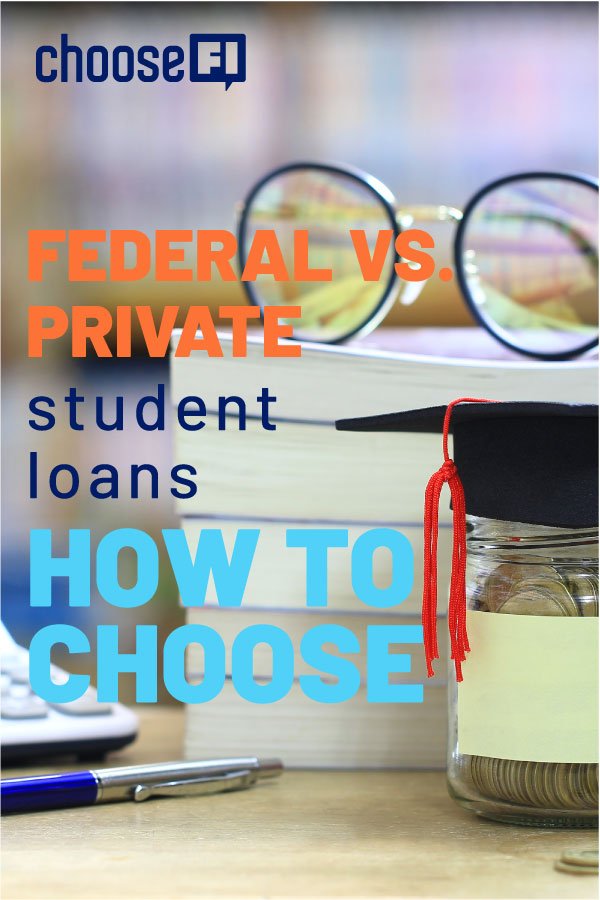Unless you’ve earned a ton of scholarships or your parents are helping to pay for your education, your likely considering student loans. Currently, over 45 million Americans are dealing with student debt. There are many different types of student loans and they all fall into one of two categories: federal vs private student loans.
So when it comes to federal vs private loans, federal loans are generally the best because of their interest rates, forbearance rules, repayment plans, and forgiveness programs.Federal Vs Private Student Loans: Where Federal Student Loans Generally Win
Federal student loans offer several benefits that private student loans simply can’t match. Here are the four biggest advantages of federal student loans.
1. Interest Rates And Terms
One of the nice things about federal student loans is that they come with fairly low fixed interest rates that aren’t based on your credit score or income. And that’s great since college students don’t typically have high salaries or credit scores.
Here are the current interest rates for the most common federal student loans:
- Direct Unsubsidized Loans: 4.53%
- Direct Subsidized Loans for Undergraduates: 4.53%
- Direct Subsidized Loans for Graduates: 6.08%
- Direct PLUS Loans: 6.08%
Another benefit of federal student loans is that there are various times when the government may pay the interest for you. For example, the Department of Education will pay the interest on your Direct Subsidized Loans while you’re in school and during your 6-month grace period.
The government will also pay all or a portion of the interest that isn’t covered by your monthly payment when you’re on an income-driven repayment plan. With most of the income-based plans, this benefit is capped at three years. But on the REPAYE plan, the government will continue to pay 50% of your unpaid interest for the life of your loan.
2. Forbearance And Deferment Rules
With federal student loans, you can place your loans in deferment during a variety of periods, like when you’re in school, unemployed, or on active military duty
You can also request up to 12 months of forbearance if you’re struggling to make your payments due to financial difficulties, medical expenses, or change of employment.
Some private lenders have tried to match certain elements of the federal forbearance and deferment rules. But, in general, don’t expect them to be nearly as generous.
3. Income-Based Repayment Plans
Federal student loans are the only student loans that allow you to make payments based on your income. These are the four income-driven plans that are currently offered:
- Pay As You Earn (PAYE)
- Revised Pay As You Earn (REPAYE)
- Income-Based Repayment (IBR)
- Income-Contingent Repayment (ICR)
With income-driven repayment (IDR) plans, you can also extend your payment schedule out 20 to 25 years. But, keep in mind, that you’ll pay more in interest (and usually more overall) with an income-based plan.
Listen: Student Loan Repayment With Travis Hornsby
4. Available Forgiveness And Discharge Programs
There are a number of ways that you can earn student loan forgiveness or discharge on your federal student loans.
Income-Driven Repayment Forgiveness
On each of the income-driven repayment plans, any balance that is remaining at the end of the repayment period will be forgiven. It should be pointed out, however, that you’ll owe income tax on whatever is forgiven.
So if you receive $75,000 of forgiveness, that could generate a tax bill of $10,000 to $25,000 depending on your tax bracket. If you plan to pursue income-driven repayment forgiveness, you’ll want to save a little each month for the tax you’ll owe.
Public Service Loan Forgiveness (PSLF)
If you work for the government or a non-profit, PSLF is probably your best student loan repayment strategy. With PSLF, you could receive forgiveness on your remaining balance in as little as ten years (120 qualifying payments).
Your payments don’t have to be consecutive either. So even if you leave your qualifying employer for a few years, you can pick back up where you left off down the road. And PSLF forgiveness is not taxable, which is a huge bonus.
Discharge Programs
In addition to its forgiveness programs, the Department of Education has also instituted a few discharge programs. For example, if you suffer a disability, you could have 100% of your student loans discharged through the Total & Permanent Disability Discharge program.
And federal loan students also come with a built-in Death Discharge benefit. So you won’t need to worry about your survivors having to shoulder the responsibility for your student loans in the event of your death.
There are several more federal forgiveness and discharge programs than listed above. But those are the most important ones. And the overall point is that there are a lot of ways that your federal student loans could go away.
In comparison, the only way to get your private student loans forgiven is to qualify for a profession-specific loan forgiveness program. But these are very rare. So if you’re hoping to earn student loan forgiveness or a student loan discharge, your best chance is with federal student loans.
Federal Vs Private Student Loans: Where Private Student Loans Generally Win
Ok, so now we’ve covered all the benefits of federal loans. By now, you may be thinking that there’s nothing good to say about private student loans. But they actually do offer a few benefits that are worth mentioning.
1. Borrower Protections
With private student loans, your lender can’t garnish your wages in the event of default unless they win a court judgment. With federal student loans, however, the government can garnish your wages at any time, skipping the court proceedings completely.
Hopefully, this wouldn’t be an issue that you’d need to worry about. But it’s important to understand that it’s incredibly hard to ever get rid of federal student loans. It’s technically possible through bankruptcy. But, even so, the rules are not in your favor.
2. Student Loan Servicing
Federal student loan servicers have massive customer loads. Whether on purpose or simply because of ineptitude, student loan servicers are infamous for mishandling student loan accounts.
For example, Navient is currently being sued by the CFPB, various state attorney generals, and a teacher’s union, for failing to allocate payments to borrowers accounts and pushing borrowers towards the wrong repayment plans.
If you have federal student loans, it’s imperative that you keep tabs on your servicer to make sure that your account is being handled appropriately.
With private student loans, however, you can expect to receive better customer service. Private lenders know that their livelihoods rely on having a good online reputation. So, in general, private lenders will be more attentive to your needs and more prone to fix problems in a timely manner.
3. Loan Limits
While federal loans come with lots of benefits and perks, they also come with lending caps. Here are the federal student loan lending caps for each year of college
- First-Year Undergrads: $9,500—No more than $3,500 may be in subsidized loans.
- Second-Year Undergrads: $10,500—No more than $4,500 may be in subsidized loans.
- Third-Year Undergrads (And Beyond): $12,500—No more than $5,500 may be in subsidized loans.
- Graduates: $20,500 (unsubsidized only)
- Aggregate Loan Limit for Undergrads: $57,500 for undergraduates—No more than $23,000 may be in subsidized loans.
- Aggregate Loan Limit for Graduates: $138,500 for graduate or professional students—No more than $65,500 may be in subsidized loans.
If you’ve hit your annual federal student loan lending cap, private student loans could help bridge your funding gap. Private student loans can generally be borrowed up to the cost of attendance.
A Grad PLUS Loan is the one type of federal student loan where you can borrow up to the cost of attendance. But they’re only available to graduate students. Plus they come with high-interest rates of 7.08% and loan fees of 4.236%.
Once you’ve maxed out your Direct Subsidized and Direct Unsubsidized Loans, private student loans could be your best choice.
4. Available Refinancing For Student Loans
Have a great credit score? Unfortunately, that doesn’t matter with federal student loans. Even if your credit score and debt-to-income ratio are fantastic, federal student loans don’t allow you refinance to a lower interest rate down the road. Everyone pays the same rate.
However, with private student loans, you can refinance at any time. That means you could be rewarded with a lower interest rate if you’ve been financially responsible. And if your parents co-signed your loans, you may be able to remove them during refinancing.
It should be pointed out that you can refinance your federal student loans at any time as well. In fact, you may even be able to transfer a Parent PLUS loan into your own name.
But once you refinance federal student loans, you’ll lose all their built-in benefits and protections. Before you refinance federal student loans, be sure to think through the pros and cons.
Related: Refinance Your Student Loans With Credible
Conclusion:
In the choice between federal vs private student loans, for most borrowers, your best choice is to start with federal student loans. They simply come with too many perks and benefits to pass up…especially while you’re still in school.
However, if you’re attending an expensive school or you’re a graduate, you may need to turn to private loans to bridge a funding gap. If so, make sure to get several quotes before choosing a lender.
Finally, once you’ve graduated and have achieved career stability, refinancing could be a smart choice. Just make sure that you fully understand the federal benefits that you’ll be surrendering in the process.
Related Articles:




